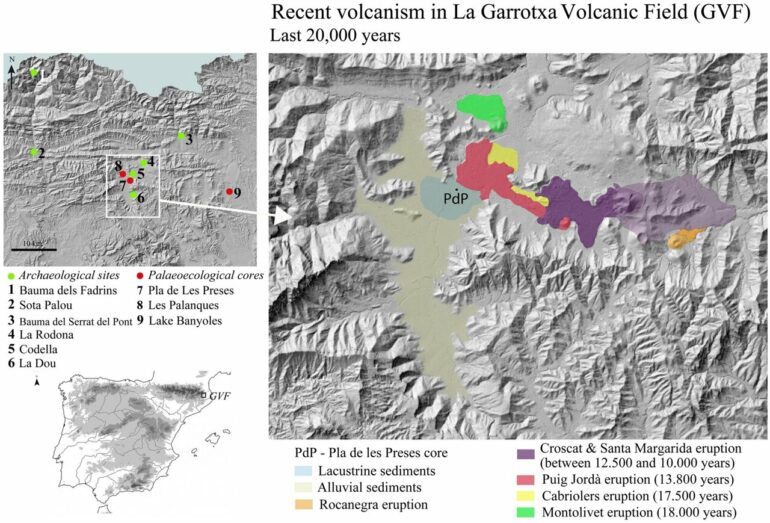A research team has carried out a study on paleoclimatic evolution, volcanic activity and its socio-ecological impact in the Garrotxa Volcanic Field (Girona). The results of the paleoenvironmental study have been published in the journals The Holocene and Scientific Reports . The Autonomous University of Barcelona, the University of Burgos, the IPHES-CERCA, the IDAEA-CSIC, the University of Valencia and the University of Montpellier participated in the study.
The study, carried out on a 14-meter deep borehole in the Vall d’en Bas (Girona), has revealed interesting and unpublished data on the paleoclimatic and paleoenvironmental evolution of the Garrotxa Volcanic Field. It shows that its volcanic activity extended to only 8,300 years ago (until now it was thought that volcanism ceased about 13,000 years ago), which constitutes the most recent volcanism in the entire Iberian Peninsula.
“It has been possible to document eruptions almost 5,000 years more recent than those recorded so far in the area, which were considered the most recent in the Iberian Peninsula, and it has been possible to characterize in detail for the first time both the social and environmental impact that to have these eruptions,” explains the researcher of the Department of Prehistory of the UAB Maria Saña, one of the main authors of the study.
This volcanic activity caused several lava flows to close the Fluvià river valley near Olot, and a large lake was formed in the plain that today is known as Pla de les Preses. The sediments that were deposited in this ancient lake surrounded by volcanoes, which include numerous layers of volcanic ash and lapilli, have been studied by different specialists through the analysis of sedimentary, paleoclimatic and biological indicators such as chronostratigraphy, sedimentology , pollen, ostracods, lake algae or diatoms. All this has made it possible to reconstruct the paleoclimatic evolution of the last 13,000 years in the north-east of the Iberian Peninsula, the volcanism of La Garrotxa and the impact of these eruptions on plant and lake ecosystems,
The sedimentary sequence of the studied borehole records local and regional signals related to the geomorphological, paleoclimatological and volcanic dynamics of the Garrotxa volcanic field. The analyzed geological and biological indicators, aquatic organisms, pollen record, sedimentology and geochemistry mainly report local hydrological variations, which have been linked to the main climatic trends of the Holocene and late Pleistocene, including several abrupt climate changes that offer clues about the processes that could be triggered in the context of current global warming.
In the area closest to the zone of volcanic activity (up to 50 km) and during volcanic eruption events, different processes such as lava flows, deposition of volcanic materials, ash rain, emanation of gases and aerosols and pyroclastic flows and earthquakes, affected flora and fauna (bioresources), as well as air and water quality, and constituted a danger to human populations.
“One of the objectives of the research has been to evaluate the dynamics of neolithization in several areas of the Eastern Pre-Pyrenees, including Garrotxa and specifically also in the Vall d’en Bas and the Llierca valley, the area where they have been documented the Mesolithic occupations contemporary to the episodes of volcanism,” says Maria Saña.
In this sense, and from the study of nearby archaeological sites, it is observed that the nearest hunter-gatherer populations left the area temporarily during periods of high volcanic activity, to return later in times of stillness, demonstrating a high capacity for reorganization and adaptation. “The abandonment of the volcanic area could take place for hundreds of years,” Saña specifies.
The published works show, in great detail, the paleoenvironmental evolution of the NE of the Iberian Peninsula and the socio-ecological impact of the volcanism that took place in La Garrotxa. In addition, they highlight the interest in developing interdisciplinary paleoecological research, which analyzes all the processes involved in the transformations of the landscape caused by volcanism and allows a better understanding of their repercussions.
More information:
Eneko Iriarte et al, Youngest Iberian Holocene volcanic eruptions and paleoenvironmental evolution of a barrier-paleolake in the Garrotxa Volcanic Field (NE Spain), The Holocene (2023). DOI: 10.1177/09596836231169989
Jordi Revelles et al, Socio-ecological impact of monogenetic volcanism in the La Garrotxa Volcanic Field (NE Iberia), Scientific Reports (2023). DOI: 10.1038/s41598-023-35072-0
Provided by
Autonomous University of Barcelona
Citation:
Volcanic activity in the Garrotxa region ended only 8,300 years ago, reveal new studies (2023, May 26)



